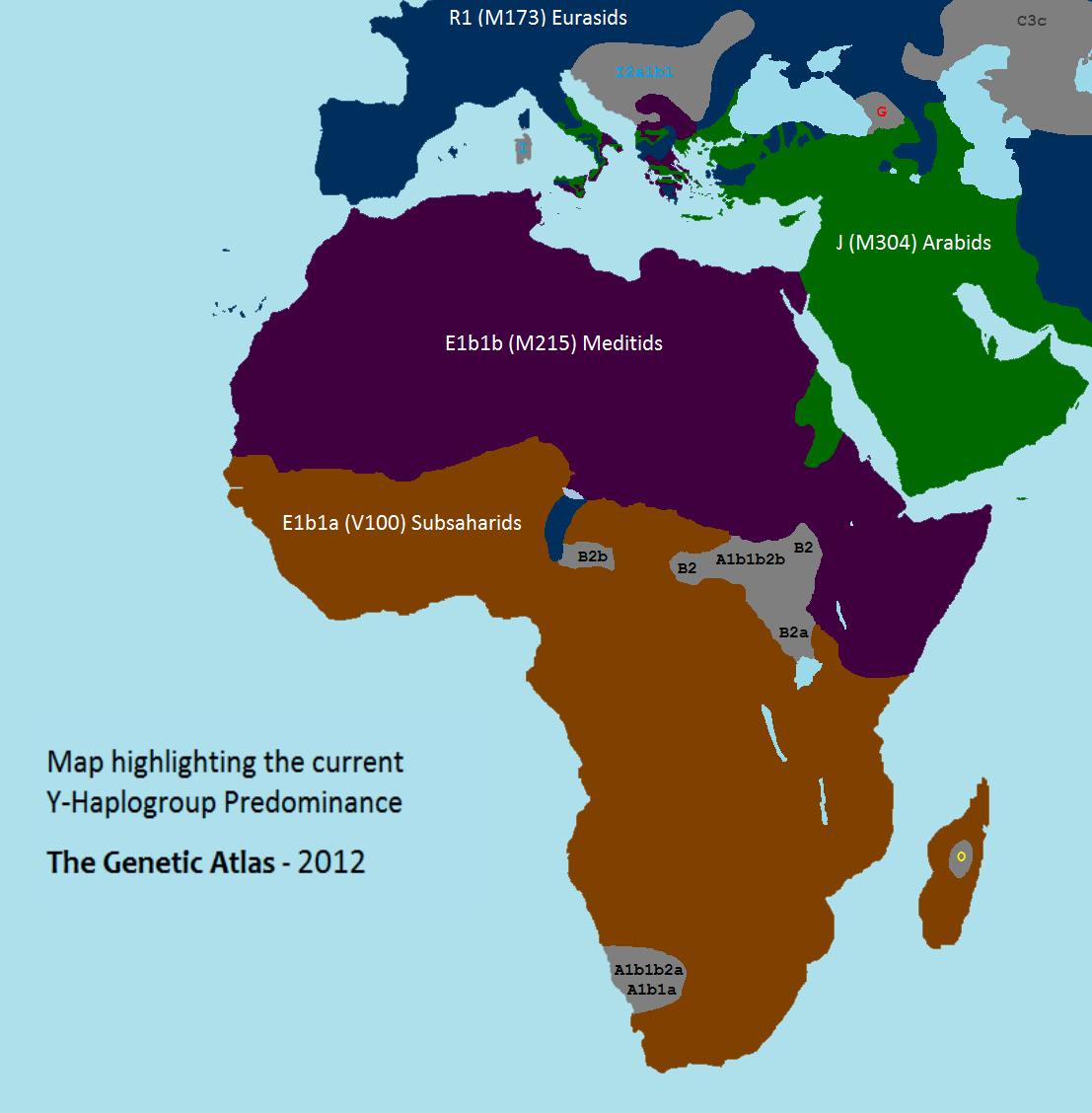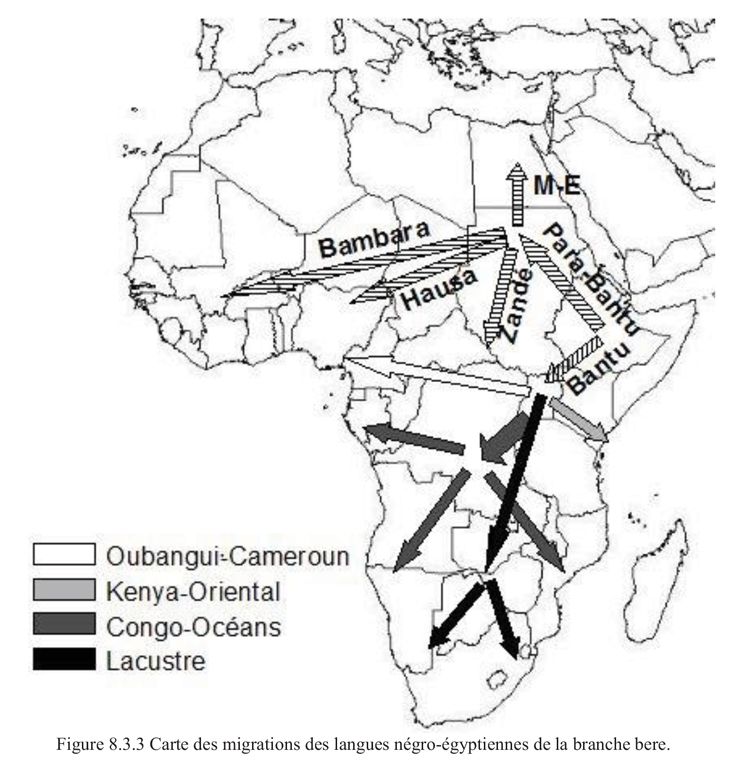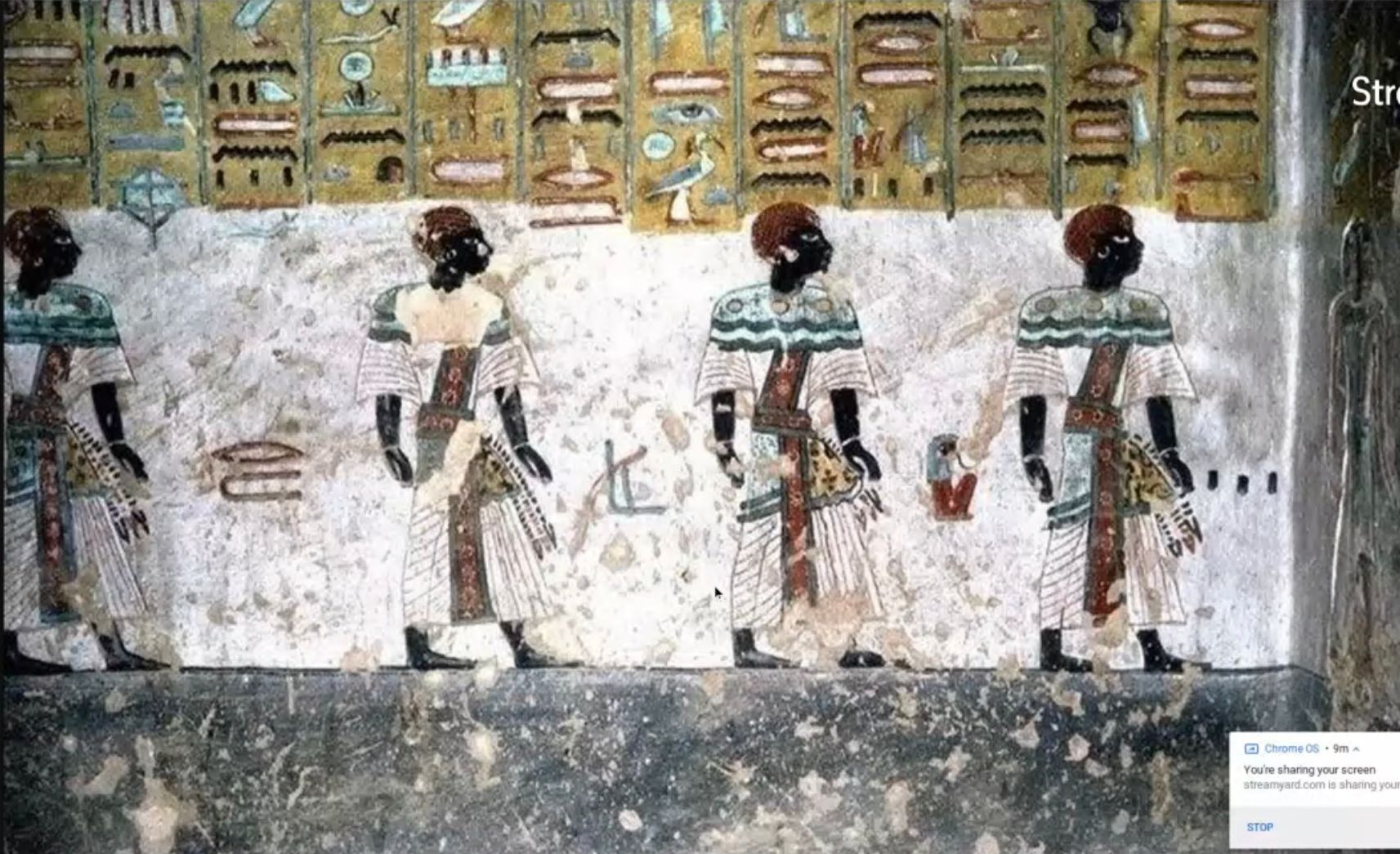You are using an out of date browser. It may not display this or other websites correctly.
You should upgrade or use an alternative browser.
You should upgrade or use an alternative browser.
A 3,300-year-old hairstyle on a preserved ancient Egyptian head
- Thread starter Prince.Skeletor
- Start date
More options
Who Replied?Dafunkdoc_Unlimited
Theological Noncognitivist Since Birth
- Joined
- Jul 25, 2012
- Messages
- 45,062
- Reputation
- 8,045
- Daps
- 122,408
- Reppin
- The Wrong Side of the Tracks
IMO, the most nonsensical answer is that Egyptians were mixed between Nubians and Middle Eastern groups.
This makes the most sense based on its geographical location, based on the variety of skintones depicted, etc.
Would've resembled modern-day Brazil with some being light/whiter toned, some being mixed/brown, some being dark/black.
In the beginning, I believe they were closer to fully black. Not because I want them to be. But because of Nabta Playa and the Green Sahara. There was a whole African civilization in what's now desert that dried up 10,000 years ago which forced people to leave for other water sources like the Nile and the Niger. This group would have had to have been mostly Black African. It takes a large leap in logic to assume Arabians came all the way down to Chad/Niger/Southern Libya instead of Africans on the same continent walking up as it was a tropical area then. Not desert.
This is neither 'nonsensical' nor requires a 'leap in logic' since trade/communication had been established all around the Mediterranean, including Lower Egypt, for a few thousand years DURING the Green Sahara period as evidenced by farming groups migrating from the Middle East and the Iberian Peninsula ~15,000 years ago.
Hunter-gatherers migrate with their prey's migration patterns.
Farmers build settlements.
It makes more sense that those who were already building settlements would build larger, permanent ones after moving South as the Sahara dried-out ~ a few thousand years BEFORE the Old Kingdom was established....

 www.cambridge.org
www.cambridge.org
This chapter reviews the current state of knowledge of early agriculture in sub-Saharan Africa from its inception in different regions to c. 500 CE. Pastoralism was the earliest form of food production in sub-Saharan Africa, developing first in North Africa c. 8,000 years ago, and gradually spreading southwards during the early to mid-Holocene while rainfall across the Sahara was significantly higher than it is today. The West African Sahel has also long been known as a locus of the domestication of pearl millet.Hunter-gatherers migrate with their prey's migration patterns.
Farmers build settlements.
It makes more sense that those who were already building settlements would build larger, permanent ones after moving South as the Sahara dried-out ~ a few thousand years BEFORE the Old Kingdom was established....

Early agriculture in sub-Saharan Africa to c. 500 ce (Chapter 18) - The Cambridge World History
The Cambridge World History - April 2015
And the earliest evidence of farming in Egypt was ~ 5,000 years ago......

The findings, which were unearthed in 2006 and are still being analyzed, also suggest possible trade links with the Red Sea, including a thoroughfare from Mesopotamia, which is known to have practiced agriculture 2,000 years before ancient Egypt.Egypt's Earliest Agricultural Settlement Unearthed
Archaeologists have found the earliest evidence ever discovered of an ancient Egyptian agricultural settlement, including farmed grains, remains of domesticated animals, pits for cooking and even floors for what appear to be dwellings. The archaeological team also found a bracelet made of a type...
www.sciencedaily.com
There's no objective evidence corroborating your theory other than speculation.
Last edited:
Ozymandeas
Veteran
This is neither 'nonsensical' nor requires a 'leap in logic' since trade/communication had been established all around the Mediterranean, including Lower Egypt, for a few thousand years DURING the Green Sahara period as evidenced by farming groups migrating from the Middle East and the Iberian Peninsula ~15,000 years ago.This chapter reviews the current state of knowledge of early agriculture in sub-Saharan Africa from its inception in different regions to c. 500 CE. Pastoralism was the earliest form of food production in sub-Saharan Africa, developing first in North Africa c. 8,000 years ago, and gradually spreading southwards during the early to mid-Holocene while rainfall across the Sahara was significantly higher than it is today. The West African Sahel has also long been known as a locus of the domestication of pearl millet.
Hunter-gatherers migrate with their prey's migration patterns.
Farmers build settlements.
It makes more sense that those who were already building settlements would build larger, permanent ones after moving South as the Sahara dried-out ~ a few thousand years BEFORE the Old Kingdom was established....

Early agriculture in sub-Saharan Africa to c. 500 ce (Chapter 18) - The Cambridge World History
The Cambridge World History - April 2015www.cambridge.org
And the earliest evidence of farming in Egypt was ~ 5,000 years ago......The findings, which were unearthed in 2006 and are still being analyzed, also suggest possible trade links with the Red Sea, including a thoroughfare from Mesopotamia, which is known to have practiced agriculture 2,000 years before ancient Egypt.

Egypt's Earliest Agricultural Settlement Unearthed
Archaeologists have found the earliest evidence ever discovered of an ancient Egyptian agricultural settlement, including farmed grains, remains of domesticated animals, pits for cooking and even floors for what appear to be dwellings. The archaeological team also found a bracelet made of a type...www.sciencedaily.com
There's no objective evidence corroborating your theory other than speculation.
This is the Green Sahara.

It is nonsense to suggest that the Green Sahara was more dominated by farming groups who traveled thousands of miles from the Middle East and Spain/Portugal to live in the dotted circle instead of Africans who were already on the continent. Maybe some Euros & Arabs were there. Some. But like you said....hunter gatherers DO travel with their prey patterns, so it is more logical to believe that Africans traveled throughout the continent to find water and food before believing white people and semitic people traveled across ocean and vast distances. Its pure stupidity to say Africans wouldn't have been near those lakes

Nothing I said was pulled out of thin air.
Egyptians said their homeland was Punt. Historians accept the Horn of Africa (Ethiopia) as its location.
At times, the ancient Egyptians called Punt Ta netjer (tꜣ nṯr), meaning "God's Land".[30] This referred to the fact that it was among the regions of the Sun God, that is, the regions located in the direction of the sunrise, to the East of Egypt. These eastern regions' resources included products used in temples, notably incense. Older literature (and current non-mainstream literature) maintained that the label "God's Land", when interpreted as "Holy Land" or "Land of the gods/ancestors", meant that the ancient Egyptians viewed the Land of Punt as their ancestral homeland.
The majority opinion places Punt in Northeastern Africa, based on the fact that the products of Punt (as depicted in the Hatshepsut illustrations) were abundantly found in the Horn of Africa but were less common or sometimes absent in Arabia. These products included gold and aromatic resins such as myrrh, frankincense, and ebony; the wild animals depicted in Punt included giraffes, baboons, hippopotami, and leopards. Richard Pankhurst states: "[Punt] has been identified with territory on both the Arabian and the Horn of Africa coasts. Consideration of the articles that the Egyptians obtained from Punt, notably gold and ivory, suggests, however, that these were primarily of African origin. ... This leads us to suppose that the term Punt probably applied more to African than Arabian territory.
Egypt and Nubia had a long and complicated relationship....as I said earlier. Nubia was a territory of Egypt for 800 years in the 2000 BC to 1000 BC period. Then Nubia flipped the script and conquered Egypt in the 700s BC during the 25th Dynasty. When historians say the 25th Dynasty was a renaissance and that it restored Egyptian culture and customs, it makes total sense when you learn that Nubia was a part of Egypt for almost a thousand years.
There's no relationship/dynamic like this between Egypt and the Middle East.
From Aswan, the southern limit of Egyptian control at the time, Egyptians imported gold, incense, ebony, copper, ivory, and exotic animals from tropical Africa through Nubia. Relations between the Egyptians and Nubians showed peaceful cultural interchange, cooperation, and mixed marriages. Nubian bowmen that settled at Gebelein during the First Intermediate Period married Egyptian women, were buried in Egyptian style, and eventually could not be distinguished from Egyptians. Some Egyptian pharaohs may have had Nubian ancestry:[49] Mentuhotep II of the 11th Dynasty "was quite possibly of Nubian origin" and Amenemhet I, founder of the 12th Dynasty, "may have had a Nubian mother".[50][51][52] However, according to F. J. Yurco, "Egyptian rulers of Nubian ancestry had become Egyptians culturally; as pharaohs, they exhibited typical Egyptian attitudes and adopted typical Egyptian policies".Yurco noted that some Middle Kingdom rulers, particularly some pharaohs of the Twelfth Dynasty had strong Nubian features, due to the origin of the dynasty in the Aswan region of southern Egypt. He also identifies the pharaoh Sequenre Tao of the Seventeenth Dynasty, as having Nubian features.
After a period of withdrawal, the Middle Kingdom of Egypt conquered Lower Nubia from 2000 to 1700 BC
From the Middle Kerma phase, the first Nubian kingdom to unify much of the region arose. The Classic Kerma culture, named for its royal capital at Kerma, was one of the earliest urban centers in the Nile region and oldest city in Africa outside of Egypt. At one point, Kerma came very close to conquering Egypt: Egypt suffered a serious defeat at the hands of the Kingdom of Kush.[62][63] According to Davies, head of the joint British Museum and Egyptian archaeological team, the attack was so devastating that, if the Kerma forces had chosen to stay and occupy Egypt, they might have permanently eliminated the Egyptians and brought the nation to extinction. During Egypt's Second Intermediate period, the Kushytes reached the height of their Bronze Age power and completely controlled southern trade with Egypt.[16]: 41 They maintained diplomatic ties with the Thebans and Hyksos until the New Kingdom pharaohs brought all of Nubia under Egyptian rule from 1500 to 1070 BC.[16]: 41 After 1070 BC, there were continued hostilities with Egypt, which led Nubians to concentrate in Upper Nubia.[16]: 58 Within 200 years, a fully formed Kushyte state, based at Napata, began to exert its influence on Upper (Southern) Egypt.
There are competing theories on the origins of the Kushyte kings of the 25th Dynasty:[77] some scholars believe they were Nubian officials that learned "state level organization" by administering Egyptian-held Nubia from 1500 to 1070 BC,[16]: 59 such as the rebel Viceroy of Kush, Panehesy, who ruled Upper Nubia and some of Lower Nubia after Egyptian forces withdrew.[61]: 110 Other scholars believe they are descended from families of the Egyptianized Nubian elite supported by Egyptian priests or settlers.[78][79][80][81] Children of elite Nubian families were sent to be educated in Egypt then returned to Kush to be appointed in bureaucratic positions to ensure their loyalty. During the Egyptian occupation of Nubia, there were temple towns with Egyptian cults, but "production and redistribution" was based mostly on indigenous social structures.
The spread of E1b1b throughout the continent coincides with Africans moving to the Green Sahara.....moving down the Horn of Africa.....moving up into Sudan/Egypt.....and moving all points south throughout the rest of Africa.


Dafunkdoc_Unlimited
Theological Noncognitivist Since Birth
- Joined
- Jul 25, 2012
- Messages
- 45,062
- Reputation
- 8,045
- Daps
- 122,408
- Reppin
- The Wrong Side of the Tracks
It is nonsense to suggest that the Green Sahara was more dominated by farming groups who traveled thousands of miles from the Middle East and Spain/Portugal to live in the dotted circle instead of Africans who were already on the continent.
It isn't nonsense and the evidence shows THEY'D BEEN THERE FOR 15,000 YEARS...spread farming techniques from the Middle East through North Africa, then Southern Africa.....
One of the greatest transitions in human history was the transition from the hunter-gatherer lifestyle to farming. How farming traditions expanded from their birthplace in the Fertile Crescent has been a matter of contention.They ARE indigenous Africans and your theory lacks the evidence to refute it.
Last edited:
This is the Green Sahara.

This map does not line up with archaeology. Especially that of West Africa.

The Bantu migration from Cameroon is a Western farce, that has been called out by African scholars in UNESCO for over half a century, and recent aDNA further discredits the argument.
Ancient West African foragers in the context of African population history
Mark Lipson, Isabelle Ribot, […]David Reich
Nature (2020)
Our knowledge of ancient human population structure in sub-Saharan Africa, particularly prior to the advent of food production, remains limited. Here we report genome-wide DNA data from four children—two of whom were buried approximately 8,000 years ago and two 3,000 years ago—from Shum Laka (Cameroon), one of the earliest known archaeological sites....However, the genome-wide ancestry profiles of all four individuals are most similar to those of present-day hunter-gatherers from western Central Africa, which implies that populations in western Cameroon today—as well as speakers of Bantu languages from across the continent—are not descended substantially from the population represented by these four people.
Our knowledge of ancient human population structure in sub-Saharan Africa, particularly prior to the advent of food production, remains limited. Here we report genome-wide DNA data from four children—two of whom were buried approximately 8,000 years ago and two 3,000 years ago—from Shum Laka (Cameroon), one of the earliest known archaeological sites....However, the genome-wide ancestry profiles of all four individuals are most similar to those of present-day hunter-gatherers from western Central Africa, which implies that populations in western Cameroon today—as well as speakers of Bantu languages from across the continent—are not descended substantially from the population represented by these four people.
The Bantu originated in the Great Lakes region, and expanded North from there.




Last edited: